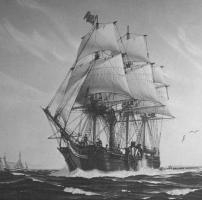 In the United States, May 22nd is celebrated as National Maritime Day. The day brings to mind a largely forgotten monument, a ship’s anchor on a concrete slab, on Corlear’s Hook in New York’s East River Park.
In the United States, May 22nd is celebrated as National Maritime Day. The day brings to mind a largely forgotten monument, a ship’s anchor on a concrete slab, on Corlear’s Hook in New York’s East River Park.
National Maritime Day was created by Congress in 1933 in honor of the sailing of the steam auxiliary packet ship Savannah sailing from her namesake city in 1819. Built as a sailing packet ship, the Savannah was outfitted with a 90 HP steam engine which drove twin paddle wheels and is credited as the first ship to cross the Atlantic under steam. The claim is a bit of a stretch, as she used her engine for 80 hours in a voyage of 29 days and 11 hours on the eastbound voyage across the Atlantic. On the westbound voyage, which lasted 40 days, she did not use her engines at all. Nevertheless, she was a technological marvel in her day. Unfortunately, Savannah was not an economic success and the steam engine was removed after her first voyage.
So what does a forgotten ship’s anchor have to do with the Savannah or National Maritime Day? It so happens that the anchor is very close to where the packet ship Savannah was built in the Fickett & Crockett shipyard at Corlear’s Hook. The area between Corlears Hook and East 14th Street was, for a brief period in the first half of the 19th century, one of the largest shipbuilding centers in the world.
But what about the anchor? If it was a monument, what was it a monument to? The truth is no one really knows. There was once a bronze plaque that, no doubt, explained it all, but the plaque went missing decades ago.
When the New York Times looked into the provenance of the anchor, almost twenty years ago, they found that “the Department of Parks and Recreation, which keeps files on such things, has no record of the missing plaque’s inscription in its archives, and the origins of the anchor, which was dedicated in 1970, are something of a mystery as well. … Jane Rudolph, a Parks Department spokeswoman, said the anchor pays tribute to a shipbuilding firm. But which one?”
Research done in the intervening years appears to have found an answer. The anchor may memorialize the entire New York shipbuilding industry, rather than a single yard.
Communitywalk.com describes the monument: The old anchor, believed to be donated by the F&M Schaefer Brewing Company, commemorates the shipbuilding industry that once thrived on Corlear’s Hook. William T. Brown’s Yard, at the foot of E 12th Street, built the schooner yacht America, designed by George Steers for the New York Yacht Club. The Crocker & Fickett yard built the full-rigged steamship Savannah in 1818, which was the first to cross the Atlantic in 1819 and sank off Fire Island. As many as 30 yards lined the riverfront by the mid-1800s, including the Thomas & Steers yard, Webb & Allen yard, and the Bishop & Simonson shipyard.
I am reminded of the East River Park anchor on National Maritime Day. Both commemorate past greatness and both are largely forgotten. The shipyards on the East River are long buried beneath a greenway and a park next to a highway, while the US merchant maritime industry is a pale shadow of what it once was. Both are worth remembering and honoring.

There is a interesting book in Rhode Island School of Design. Written by one Admiral Nelson. It was a review of designs that had been compiled for the queen. Alot of the designs were of the wiggle cylinder design used by modelers today. Their designs were so primitive that I wouldnt be surprised if the cylinders fell off the engine during the trip and were probably scrap at the end of her voyage.
Yet we dont know what design she used. Granted paddle boats in the later years used walking beam engines. They are truly a sight to see if ever one can.